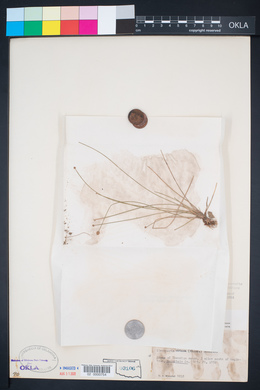Eleocharis obtusa
|
|
|
|
Family: Cyperaceae
Blunt Spike-Rush
[Eleocharis obtusa var. ellipsoidalis Fernald in Svenson, moreEleocharis obtusa var. gigantea Fernald, Eleocharis obtusa var. jejuna Fernald, Eleocharis obtusa var. peasei Svenson, Eleocharis ovata var. obtusa , Scirpus obtusus Willd.] |
Culms 3-50(-90) cm × 0.2-2 mm. Leaves: apex of distal leaf sheath obtuse to acute, tooth to 0.3 mm. Spikelets broadly ovoid (to ellipsoid or lanceoloid), apex rounded (to acute), (2-)5-13 × (2-)3-4 mm; floral scales 15-150+, 8-20 per mm of rachilla, orange-brown (to stramineous), elliptic, 1.5-2.5 × 1-1.5 mm, midribs seldom keeled, apex broadly rounded. Flowers: perianth bristles (5-)6-7, rarely 0, brown, stout, slightly to usually greatly exceeding tubercle; stamens usually 3; anthers brown to yellow, 0.3-0.6 mm; styles usually 3-fid and 2-fid in same spikelet. Achenes 0.9-1.2(-1.3) × 0.7-0.9 mm. Tubercles deltoid 0.35-0.5 × (0.4-)0.5-0.8 mm, 1/3-2/3 as high as wide, 1/3-1/2 as high and 2/3-9/10 as wide as achene. 2n = 10. Fruiting summer-fall. Fresh shores, marshes, disturbed places; 10-1600 m; B.C., N.S., Ont., P.E.I., Que.; Ala., Ark., Calif., Colo., Conn., Del., D.C., Fla., Ga., Idaho, Ill., Ind., Iowa, Kans., Ky., La., Maine, Mass., Mich., Minn., Miss., Mo., Nebr., N.H., N.J., N.Y., N.C., Ohio, Okla., Oreg., Pa., R.I., S.C., Tenn., Tex., Vt., Va., Wash., W.Va., Wis., Wyo.; Pacific Islands (Hawaii). Extremely uncommon plants of Eleocharis obtusa without perianth bristles may be called E. obtusa var. peasei (type from New Hampshire). Robust plants with distinct caudices, floral scales 2.5 mm, and achenes 1.2-1.3 mm (Eleocharis obtusa var. gigantea Fernald) are rare (specimens seen from the Washington-British Columbia border [type], Arkansas, and the Hawaiian Islands). Dwarf plants (E. obtusa var. jejuna Fernald, type from Maine), with unusually small achenes and floral scales, and tubercles often less than 0.5 mm wide, are occasional in the East and are easily confused with E. ovata and E. aestuum. A few specimens are intermediate with E. engelmannii. Eleocharis obtusa is sometimes treated as conspecific with E. ovata, which consistently differs in its mostly 2-fid styles, mostly two stamens, and especially its narrower tubercles (B. M. H. Larson and P. M. Catling 1996). Eleocharis macounii Fernald has been treated as a synonym of E. obutsa (H. K. Svenson 1957) but is more probably a hybrid between E. intermedia and E. obtusa (P. M. Catling and S. G. Hay 1993; see 34. E. intermedia).
Annual herb, tufted 3 cm - 0.5 m tall Leaves: reduced to bladeless sheaths, basal, two per culm, margins fused and enclosing culm, with a blunt to pointed apex which bears a tiny tooth. Flowers: minute, spirally arranged on the axis of the spikelet, lacking sepals and petals, with five to seven bristles (sometimes reduced or lacking), subtended by a scale. Bristles brown, equal to or longer than the achene, stout, shortly barbed. Stamens usually three, exserted. Anthers brown to yellow, to about 0.5 mm long. Pistil one. Style often two- and three-cleft within the same spikelet. Fruit: a one-seeded achene, straw-colored to olive or brown, about 1 mm long and wide, lenticular (lens-shaped), shiny. Tubercle tiny, triangular. Seed with a thin, non-adherent wall. Culm: unbranched, 3 cm - 0.5 m long, 0.5 - 2 mm wide, ribbed, enclosed basally by two fused sheaths. Spikelets: solitary, 5 - 13 mm long, 3 - 4 mm wide, broadly egg-shaped with a rounded apex, with 15 to 150 or more floral scales. Scales spirally arranged and overlapping, orangish brown, 1.5 - 2.5 mm long, 1 - 1.5 mm wide, elliptical with a broadly rounded apex. Similar species: No information at this time. Flowering: mid-May to late September Habitat and ecology: Common on shores and moist flats, often around artificial ponds. It is also found in calcareous marshy areas, small sandy ditches, and interdunal flats near Lake Michigan. Occurence in the Chicago region: native Etymology: Eleocharis comes from the Greek words heleios, meaning "dwelling in a marsh," and charis, meaning grace. Obtusa means blunt. Author: The Morton Arboretum From Flora of Indiana (1940) by Charles C. Deam Throughout the state in muddy or wet places in almost all habitats, principally in ditches, sloughs, swamps, and ponds and on the borders of streams and lakes. The species is variable and my no. 45541 from Monroe County and no. 24288 from Posey County are here cited as exceptional plants. I have a specimen from a tamarack bog in La Porte County that Svenson refers to [variety ellipsoidalis, a form with ellipsoidal rather than ovoid-cylindric spikelets]. ...... Indiana Coefficient of Conservatism: C = 1 Wetland Indicator Status: OBL |




































































































